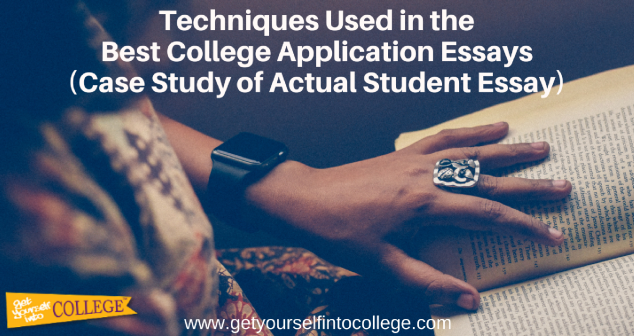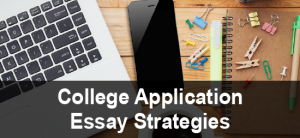The best college application essays are works of creative nonfiction, a genre which draws on “literary styles and techniques to create factually accurate narratives.”
I’m talking about your Common Application essay and main personal narratives for non-Common App schools or other types of applications (e.g., the Coalition for Access & Affordability or the Universal College Application).Your supplemental essays usually require a different, more straightforward style. Click here to read about strategies for supplemental essays.
Examples from an actual college application essay will introduce you to the conventions of the creative nonfiction genre and techniques you can use in your own essays.
“Standout” College Application Essay
Jonathan Ababiy’s college application essay was featured in the New York Times as an example of a “standout” essay on “money, work or social class.” Click here to access the full essay and three other student essays.
1st PARAGRAPH – TAKING THE PLUNGE INSTEAD OF STATING A THESIS
Let’s take a look at how he starts his essay:
“At age 6, I remember the light filled openness of the house, how the whir of my mother’s vacuum floated from room to room. At 9, I remember how I used to lounge on the couch and watch Disney cartoons on the sideways refrigerator of a TV implanted in a small cave in the wall. At 12, I remember family photographs of the Spanish countryside hanging in every room. At 14, I remember vacuuming each foot of carpet in the massive house and folding pastel shirts fresh out of the dryer.”
Notice that he doesn’t begin with the kind of traditional opening paragraph you need in your academic essays. There’s no thesis statement, we don’t know which essay prompt he’s chosen, and he doesn’t share the main points he’s going to address in his essay. In school, you’d probably get points taken off if your first paragraph didn’t have these elements.
A Common Application essay isn’t a regular academic essay. Including the usual details will usually weaken the force of your narrative.
Jonathan plunges us into his life and gives us a quick journey with very vivid details. We can really see the space he’s describing and what he’s doing in this environment. Even though he’s telling us facts, the emphasis is on showing us them.
This process of plunging readers into a world or a character’s mind is something we associate with novels and films and is a good example of how Common Application essays are closely aligned with the genre of creative nonfiction.
3rd PARAGRAPH – THE TWIST & VARIATION
After drawing us into what seems like a life of privilege, Jonathan introduces a twist that challenges our preconceptions about his life:
“But the vacuum my mother used wasn’t ours. We never paid for cable. The photographs weren’t of my family. The carpet I vacuumed I only saw once a week, and the pastel shirts I folded I never wore. The house wasn’t mine. My mother was only the cleaning lady, and I helped.”
These six sentences constitute the entirety of the paragraph. Vary the length of your paragraphs and having a mixture of short and long sentences. Variation is a hallmark of excellent writing and a way to enhance the pacing of your essay.
His essay would have lost its force if he started by announcing that his focus will be on how his parents came to the US “as refugees almost twenty years ago from the country of Moldova” and how his experience in the professors’ house where his mom work shaped his own life.
How you tell your story is super important.
Jonathan isn’t just telling his story. He isn’t just showing us his world. He’s taking readers on a journey with twists and turns.
This is exactly what great stories do.
One of Jonathan’s twists involves making us see a world of privilege and then revealing this wasn’t his home. It was the home of his mother’s employer.
You know how satisfying it is when you’re plunged into the world of a character who’s experiencing some sort of internal and/or external tension. You get to enter her process of grappling with this tension and trying to resolve it. It’s rarely a very straightforward process. There are ups and downs. In traditional narratives, the tension gets resolved.
Imagine how boring it would be to read or watch something without these elements. You want your reader to go through something while reading your essay.
So in your Common Application essay, you want to. . .
SHOW YOUR PROCESS!!!!
SHOW YOUR TWISTS AND TURNS.
MAKE SURE YOU HAVE SOME SORT OF INTERNAL AND/OR EXTERNAL TENSION.
6th PARAGRAPH: THE SHIFT & PERSPECTIVE ON EXPERIENCES
Up until now, Jonathan’s predominant focus has been on his mother and his family background. Now he’s going to show us how “the professors’ home was a telescope to how the other (more affluent) half lived.” He describes “the lightly crinkled New York Times sprawled on the kitchen table” and “the overturned, half-opened books in their overflowing personal library.”
It’s not only that he was exposed to a different world.
Jonathan shows us how his life changed as a result of this exposure. He describes how he “began to check out books from the school library and started reading the news religiously.” He shares his discovery of “a mythical place called Silicon Valley” and how “the life that I saw through” the professors’ home showed him “that an immigrant could succeed in America, too.”
THIS IS SO IMPORTANT!!!!
In your Common Application essay, you need to shed light on how your experiences have influenced the way you think about yourself and/or others. Sometimes this also involves indicating how they’ve even changed the way you act.
Take a quick look at two of the Common Application topics:
“The lessons we take from obstacles we encounter can be fundamental to later success. Recount a time when you faced a challenge, setback, or failure. How did it affect you, and what did you learn from the experience?” Click here to read my article on the “failure” essay topic.
“Discuss an accomplishment, event, or realization that sparked a period of personal growth and a new understanding of yourself or others.” Click here to read my article on the “personal growth” topic.
Although the other essay prompts don’t explicitly ask about how your experiences have influenced the way you think and act in other situations, it’s still (almost always) important to offer some insight on these issues.
Sometimes you need to weave this perspective into the main body of your narrative to show your process of change. Let’s say you are writing about “a time when you questioned or challenged a belief or idea.” The topic asks you to describe “what prompted your thinking” and the “outcome.” Show your process of thinking critically about the belief or idea you’ve decided to question or challenge. Admissions officers are curious people. They want to learn about your habits of mind. Colleges don’t want students who rashly jump to conclusions and can’t handle engaging in respectful discussions with people who have very different points of view, so this Common App essay topic is a great way to reveal that you are capable of thinking through your decision to challenge other people’s beliefs or ideas. You could describe each phase of your thinking process, how (and why) you felt certain ways and then end with the questioning or challenging. Click here to read my article on questioning and challenging a belief or idea.
8th PARAGRAPH: THE CONCLUSION
Writing a great conclusion isn’t easy. It’s hard to avoid cliches.
I like Jonathan’s conclusion:
“Ultimately, the suction of the vacuum is what sustains my family. The squeal of her vacuum reminds me why I have the opportunity to drive my squealing car to school. I am where I am today because my mom put an enormous amount of labor into the formula of the American Dream. It’s her blue Hoover vacuums that hold up the framework of my life. Someday, I hope my diploma can hold up the framework of hers.”
He manages to bring together the various threads of his narrative and end with a forward-looking vision. I enjoy the way he connects the “squeal” of his mom’s vacuum to that of his car’s own “squealing.” This is an example of strategic repetition.
Meghan Cleary’s “Dad’s Girlfriend” also has a great conclusion. Listen to this Harvard student’s narrative. Most of it focuses on showing us her family’s experience. Towards the end, she starts “telling” about her perspective on how this is “a story about love, about the people that we remember, somehow, when we remember nothing else.” In the penultimate paragraph, she notes:
“This story is also about loss. It reminds me that life is fleeting, and that everything can change in an instant, quite literally, in a heartbeat. Life is short. The time we have to make memories, to love, is limited. We have to make the most of it.”
Her talk would NOT have been so powerful if she started off by “telling” us the way she does here at the end.
As Michael Zuckerman points out, Meghan’s story brought everyone–“some 100-odd students, tutors, dining staff, and Lowell House master Diana Eck and co-master Dorothy Austin–to stunned silence and then catharsis.”
Wouldn’t you love to have this kind of effect on admissions officers?
Wouldn’t you love to write one of the best application essays?
Experiment with ways of striking just the right balance between showing and telling. Explore multiple ways of ending your application essay.
WAYS TO WORK WITH DR. BERNSTEIN!
Click here to learn how to schedule a private consultation with Dr. Bernstein.
Click here to learn more about Dr. Bernstein’s ongoing private college preparation and college admissions support.
Click here to learn about the online Get Yourself Into College® program.
Blog post image used: ©Prasanna Kumar/unsplash.com



